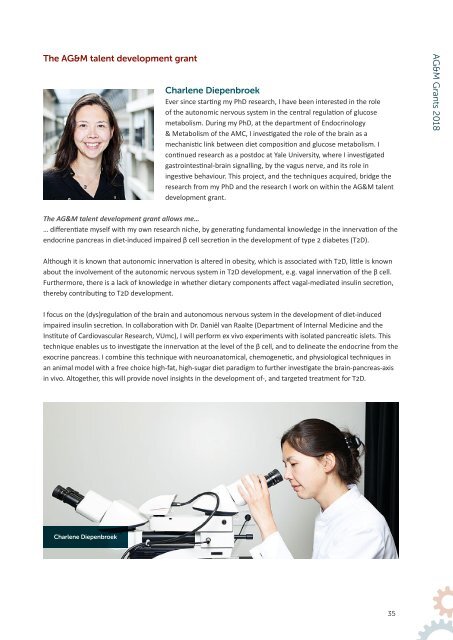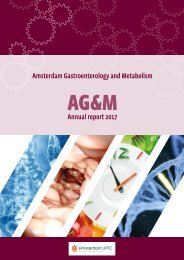AG&M annual report 2018
You also want an ePaper? Increase the reach of your titles
YUMPU automatically turns print PDFs into web optimized ePapers that Google loves.
The AG&M talent development grant<br />
Charlene Diepenbroek<br />
Ever since starting my PhD research, I have been interested in the role<br />
of the autonomic nervous system in the central regulation of glucose<br />
metabolism. During my PhD, at the department of Endocrinology<br />
& Metabolism of the AMC, I investigated the role of the brain as a<br />
mechanistic link between diet composition and glucose metabolism. I<br />
continued research as a postdoc at Yale University, where I investigated<br />
gastrointestinal-brain signalling, by the vagus nerve, and its role in<br />
ingestive behaviour. This project, and the techniques acquired, bridge the<br />
research from my PhD and the research I work on within the AG&M talent<br />
development grant.<br />
AG&M Grants <strong>2018</strong><br />
The AG&M talent development grant allows me…<br />
… differentiate myself with my own research niche, by generating fundamental knowledge in the innervation of the<br />
endocrine pancreas in diet-induced impaired β cell secretion in the development of type 2 diabetes (T2D).<br />
Although it is known that autonomic innervation is altered in obesity, which is associated with T2D, little is known<br />
about the involvement of the autonomic nervous system in T2D development, e.g. vagal innervation of the β cell.<br />
Furthermore, there is a lack of knowledge in whether dietary components affect vagal-mediated insulin secretion,<br />
thereby contributing to T2D development.<br />
I focus on the (dys)regulation of the brain and autonomous nervous system in the development of diet-induced<br />
impaired insulin secretion. In collaboration with Dr. Daniël van Raalte (Department of Internal Medicine and the<br />
Institute of Cardiovascular Research, VUmc), I will perform ex vivo experiments with isolated pancreatic islets. This<br />
technique enables us to investigate the innervation at the level of the β cell, and to delineate the endocrine from the<br />
exocrine pancreas. I combine this technique with neuroanatomical, chemogenetic, and physiological techniques in<br />
an animal model with a free choice high-fat, high-sugar diet paradigm to further investigate the brain-pancreas-axis<br />
in vivo. Altogether, this will provide novel insights in the development of-, and targeted treatment for T2D.<br />
Charlene Diepenbroek<br />
35



